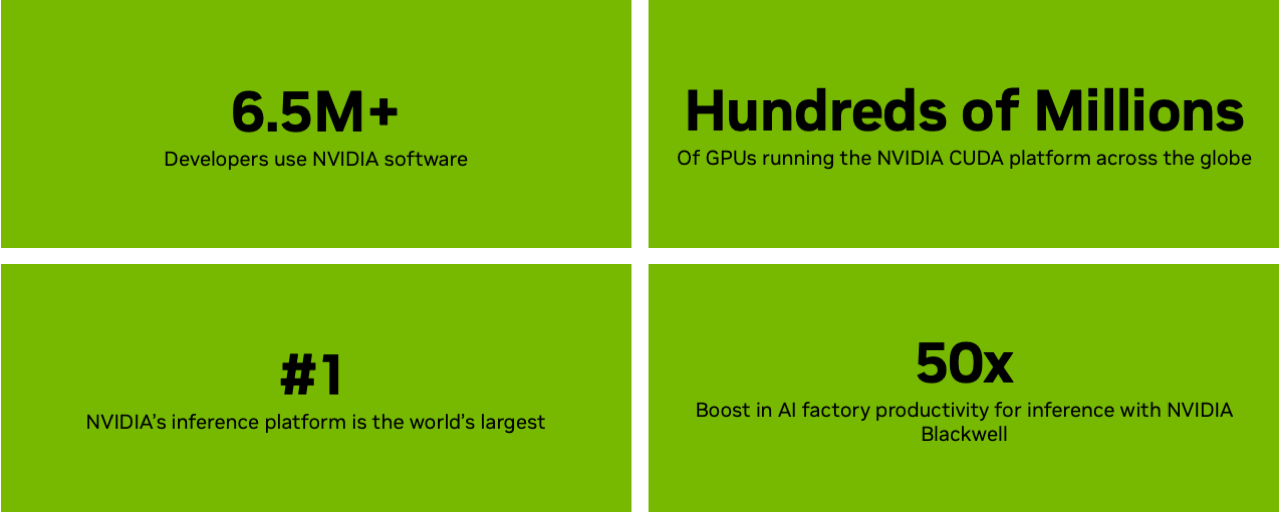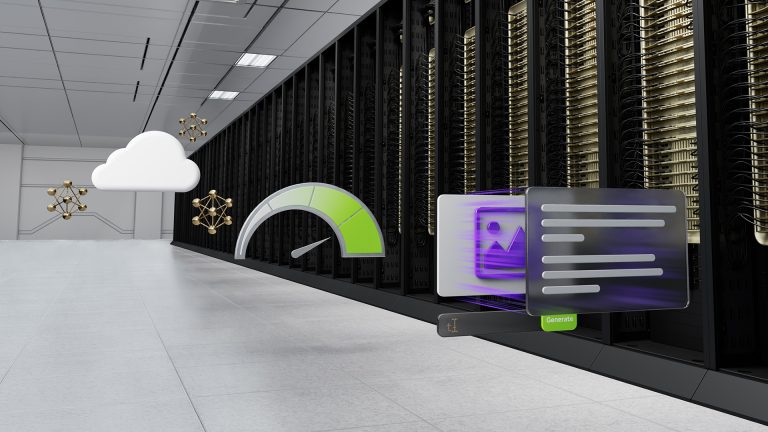From AI assistants doing deep research to autonomous vehicles making split-second navigation decisions, AI adoption is exploding across industries.
Behind every one of those interactions is inference — the stage after training where an AI model processes inputs and produces outputs in real time.
Today’s most advanced AI reasoning models — capable of multistep logic and complex decision-making — generate far more tokens per interaction than older models, driving a surge in token usage and the need for infrastructure that can manufacture intelligence at scale.
AI factories are one way of meeting these growing needs.
But running inference at such a large scale isn’t just about throwing more compute at the problem.
To deploy AI with maximum efficiency, inference must be evaluated based on the Think SMART framework:
- Scale and complexity
- Multidimensional performance
- Architecture and software
- Return on investment driven by performance
- Technology ecosystem and install base
Scale and Complexity
As models evolve from compact applications to massive, multi-expert systems, inference must keep pace with increasingly diverse workloads — from answering quick, single-shot queries to multistep reasoning involving millions of tokens.
The expanding size and intricacy of AI models introduce major implications for inference, such as resource intensity, latency and throughput, energy and costs, as well as diversity of use cases.
To meet this complexity, AI service providers and enterprises are scaling up their infrastructure, with new AI factories coming online from partners like CoreWeave, Dell Technologies, Google Cloud and Nebius.
Multidimensional Performance
Scaling complex AI deployments means AI factories need the flexibility to serve tokens across a wide spectrum of use cases while balancing accuracy, latency and costs.
Some workloads, such as real-time speech-to-text translation, demand ultralow latency and a large number of tokens per user, straining computational resources for maximum responsiveness. Others are latency-insensitive and geared for sheer throughput, such as generating answers to dozens of complex questions simultaneously.
But most popular real-time scenarios operate somewhere in the middle: requiring quick responses to keep users happy and high throughput to simultaneously serve up to millions of users — all while minimizing cost per token.
For example, the NVIDIA inference platform is built to balance both latency and throughput, powering inference benchmarks on models like gpt-oss, DeepSeek-R1 and Llama 3.1.
What to Assess to Achieve Optimal Multidimensional Performance
- Throughput: How many tokens can the system process per second? The more, the better for scaling workloads and revenue.
- Latency: How quickly does the system respond to each individual prompt? Lower latency means a better experience for users — crucial for interactive applications.
- Scalability: Can the system setup quickly adapt as demand increases, going from one to thousands of GPUs without complex restructuring or wasted resources?
- Cost Efficiency: Is performance per dollar high, and are those gains sustainable as system demands grow?
Architecture and Software
AI inference performance needs to be engineered from the ground up. It comes from hardware and software working in sync — GPUs, networking and code tuned to avoid bottlenecks and make the most of every cycle.
Powerful architecture without smart orchestration wastes potential; great software without fast, low-latency hardware means sluggish performance. The key is architecting a system so that it can quickly, efficiently and flexibly turn prompts into useful answers.
Enterprises can use NVIDIA infrastructure to build a system that delivers optimal performance.
Architecture Optimized for Inference at AI Factory Scale
The NVIDIA Blackwell platform unlocks a 50x boost in AI factory productivity for inference — meaning enterprises can optimize throughput and interactive responsiveness, even when running the most complex models.
The NVIDIA GB200 NVL72 rack-scale system connects 36 NVIDIA Grace CPUs and 72 Blackwell GPUs with NVIDIA NVLink interconnect, delivering 40x higher revenue potential, 30x higher throughput, 25x more energy efficiency and 300x more water efficiency for demanding AI reasoning workloads.
Further, NVFP4 is a low-precision format that delivers peak performance on NVIDIA Blackwell and slashes energy, memory and bandwidth demands without skipping a beat on accuracy, so users can deliver more queries per watt and lower costs per token.
Full-Stack Inference Platform Accelerated on Blackwell
Enabling inference at AI factory scale requires more than accelerated architecture. It requires a full-stack platform with multiple layers of solutions and tools that can work in concert together.
Modern AI deployments require dynamic autoscaling from one to thousands of GPUs. The NVIDIA Dynamo platform steers distributed inference to dynamically assign GPUs and optimize data flows, delivering up to 4x more performance without cost increases. New cloud integrations further improve scalability and ease of deployment.
For inference workloads focused on getting optimal performance per GPU, such as speeding up large mixture of expert models, frameworks like NVIDIA TensorRT-LLM are helping developers achieve breakthrough performance.
With its new PyTorch-centric workflow, TensorRT-LLM streamlines AI deployment by removing the need for manual engine management. These solutions aren’t just powerful on their own — they’re built to work in tandem. For example, using Dynamo and TensorRT-LLM, mission-critical inference providers like Baseten can immediately deliver state-of-the-art model performance even on new frontier models like gpt-oss.
On the model side, families like NVIDIA Nemotron are built with open training data for transparency, while still generating tokens quickly enough to handle advanced reasoning tasks with high accuracy — without increasing compute costs. And with NVIDIA NIM, those models can be packaged into ready-to-run microservices, making it easier for teams to roll them out and scale across environments while achieving the lowest total cost of ownership.
Together, these layers — dynamic orchestration, optimized execution, well-designed models and simplified deployment — form the backbone of inference enablement for cloud providers and enterprises alike.
Return on Investment Driven by Performance
As AI adoption grows, organizations are increasingly looking to maximize the return on investment from each user query.
Performance is the biggest driver of return on investment. A 4x increase in performance from the NVIDIA Hopper architecture to Blackwell yields up to 10x profit growth within a similar power budget.
In power-limited data centers and AI factories, generating more tokens per watt translates directly to higher revenue per rack. Managing token throughput efficiently — balancing latency, accuracy and user load — is crucial for keeping costs down.
The industry is seeing rapid cost improvements, going as far as reducing costs-per-million-tokens by 80% through stack-wide optimizations. The same gains are achievable running gpt-oss and other open-source models from NVIDIA’s inference ecosystem, whether in hyperscale data centers or on local AI PCs.
Technology Ecosystem and Install Base
As models advance — featuring longer context windows, more tokens and more sophisticated runtime behaviors — their inference performance scales.
Open models are a driving force in this momentum, accelerating over 70% of AI inference workloads today. They enable startups and enterprises alike to build custom agents, copilots and applications across every sector.
Open-source communities play a critical role in the generative AI ecosystem — fostering collaboration, accelerating innovation and democratizing access. NVIDIA has over 1,000 open-source projects on GitHub in addition to 450 models and more than 80 datasets on Hugging Face. These help integrate popular frameworks like JAX, PyTorch, vLLM and TensorRT-LLM into NVIDIA’s inference platform — ensuring maximum inference performance and flexibility across configurations.
That’s why NVIDIA continues to contribute to open-source projects like llm-d and collaborate with industry leaders on open models, including Llama, Google Gemma, NVIDIA Nemotron, DeepSeek and gpt-oss — helping bring AI applications from idea to production at unprecedented speed.

The Bottom Line for Optimized Inference
The NVIDIA inference platform, coupled with the Think SMART framework for deploying modern AI workloads, helps enterprises ensure their infrastructure can keep pace with the demands of rapidly advancing models — and that each token generated delivers maximum value.
Learn more about how inference drives the revenue generating potential of AI factories.
For monthly updates, sign up for the NVIDIA Think SMART newsletter.



